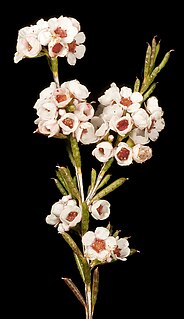
Myrtaceae or the myrtle family is a family of dicotyledonous plants placed within the order Myrtales. Myrtle, pohutukawa, bay rum tree, clove, guava, acca (feijoa), allspice, and eucalyptus are some notable members of this group. All species are woody, contain essential oils, and have flower parts in multiples of four or five. The leaves are evergreen, alternate to mostly opposite, simple, and usually entire. The flowers have a base number of five petals, though in several genera the petals are minute or absent. The stamens are usually very conspicuous, brightly coloured and numerous.
Deltasaurus kimberleyensis was a temnospondyl amphibian of the family Rhytidosteidae that existed during the Carnian stage of the Triassic. The fossilised remains were discovered in the Blina Shale formation in the Kimberley region of northwest Australia in 1965.
John William Green is an Australian botanist.

Deltasaurus is an extinct genus of Carnian temnospondyl amphibian of the family Rhytidosteidae.
Deltasaurus pustulatus is an amphibian fossil species of the family Rhytidosteidae. The temnospondyl hunted invertebrates and fish during the late stage Triassic epoch, and somewhat resembles the only other species of the eastern Gondwanan genus Deltasaurus. The only known evidence of the species was discovered in a drill core in Southwest Australia, near Geraldton, a seemingly improbable event that produced the only known example of Triassic vertebrate fauna in the ecologically exceptional region's Kockatea Formation.

Chamelaucieae is a tribe of flowering plants within the family Myrtaceae, mostly from Australia, with a few species in New Caledonia and south-east Asia.

Malleostemon is a genus of flowering plants in the myrtle family Myrtaceae, described as a genus in 1983, by John Green The entire genus is endemic to Western Australia.
- Malleostemon costatusRye & Trudgen
- Malleostemon decipiens(W.Fitzg.) Trudgen
- Malleostemon hursthousei(W.Fitzg.) J.W.Green
- Malleostemon microphyllusRye & Trudgen
- Malleostemon minilyaensisJ.W.Green
- Malleostemon nephroideusRye
- Malleostemon nerrenensisRye & Trudgen
- Malleostemon pedunculatusJ.W.Green
- Malleostemon peltiger(S.Moore) J.W.Green
- Malleostemon pustulatusRye
- Malleostemon roseus(E.Pritz.) J.W.Green
- Malleostemon tuberculatus(E.Pritz.) J.W.Green
- Malleostemon uniflorusRye
Malleostemon decipiens is a plant species of the family Myrtaceae endemic to Western Australia.
Malleostemon hursthousei is a plant species of the family Myrtaceae endemic to Western Australia.
Malleostemon microphyllus is a plant species of the family Myrtaceae endemic to Western Australia.
Malleostemon costatus is a plant species of the family Myrtaceae endemic to Western Australia.
Malleostemon minilyaensis is a plant species of the family Myrtaceae endemic to Western Australia.
Malleostemon pedunculatus is a plant species of the family Myrtaceae endemic to Western Australia.
Malleostemon peltiger is a plant species of the family Myrtaceae endemic to Western Australia.
Malleostemon nephroideus is a plant species of the family Myrtaceae endemic to Western Australia.
Malleostemon nerrenensis is a plant species of the family Myrtaceae endemic to Western Australia.
Malleostemon roseus is a plant species of the family Myrtaceae endemic to Western Australia.

Malleostemon tuberculatus is a plant species of the family Myrtaceae endemic to Western Australia.
Malleostemon uniflorus is a plant species of the family Myrtaceae endemic to Western Australia.
Malcolm Eric Trudgen is a West Australian botanist. He has published some 105 botanical names. He currently runs his own consulting company, ME Trudgen and Associates.




